With whitetail season coming up in Texas, I’ve welcomed a slew of lever-action rifles for review. This season, I feel sorry for every lever gun that follows this one. Grizzly Custom Guns once again sets a high bar with the Marlin 1895 Outback Guide gun in the venerable .45-70.

The Grizzly Custom Guns Outback Guide tips the scales at just over eight pounds (unloaded, with scope). Considering the .45-70’s potential punch, it’s not a particularly heavy rifle. As I teed-up 300 rounds for this test, I figured this review could be punishing.
Thankfully, Mr. Bonitz ameliorated most of the anguish by adding a cut and contoured Pachmayr Decelerator recoil pad to the original Marlin checkered and laminated stock.
Marlin hasn’t changed their lever gun’s stock’s overall geometry in a long time. Like the shark, it didn’t need to evolve. So it’s just as well Grizzly gun guru Lew Bonitz left well enough alone.
The grey laminated stock looks pretty good on factory stainless steel Marlins. It looks much better on the Outback’s highly polished receiver. Especially as every other metal bit also has a satin sheen. I’m a big fan of blued guns, but the Outback’s stainless steel’s siren song sings sweetly indeed.
With its 18.5″ barrel, the Outback Guide stretches 36 1/2″ from nose to tail. That makes the Guide extremely handy in heavy brush. With it’s generally short length, well-sorted stock geometry and Pachmayr pad, the Guide points like a stick. It flew up to my shoulder, right in line, ready to shoot, regardless of whether I was using the ghost ring iron sights or the Leupold scout scope.
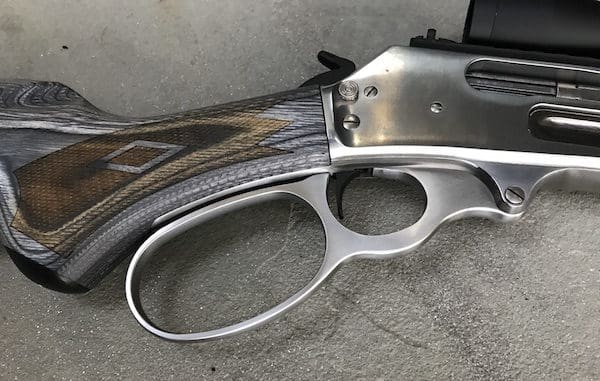
Many 1895s — especially the newer ones — have sharp angles on the lever loop. If you’re firing a few rounds, it’s not an issue. But fast cycling dozens of rounds soon becomes uncomfortable, even bruising. Grizzly has solved that problem by removing all the factory Marlin’s sharp edges and burrs, smoothing out the 1895’s every line.
Cycling the Outback Guide’s action, all you feel is the rifle’s butter smooth function. I didn’t disassemble the receiver, but a flashlight and a magnifying glass revealed that Lew polished all the parts and squared where need be. The end result is a radically improved cycling speed and satisfaction. Not to mention a longer service life and improved overall reliability.

I hate to despoil a lever gun’s cowboy cool with a rail, but there’s no denying the utility of the Outback Guide’s XS Sights rail. For those of you who share my preference for night hunting wild hogs, the rail accommodates night vision or IR pointing devices, making this lever gun a big bore nighttime terror on even the baddest of the piggies.
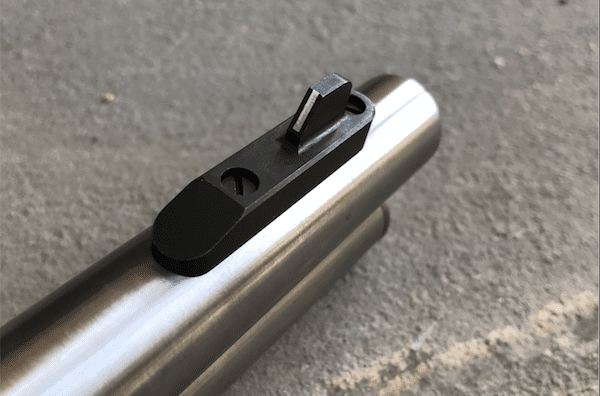
Alternatively, the Guide’s top rail quickly accommodates a long eye relief scope. Going all iron is easy enough; Grizzly sets the XS Sights’ ghost ring rear sight into the mounted rail. Combined with the XS Sights ramped front sight, complete with high visibility insert, punching huge holes in water jugs or taking game close-in without a scope is a done deal.
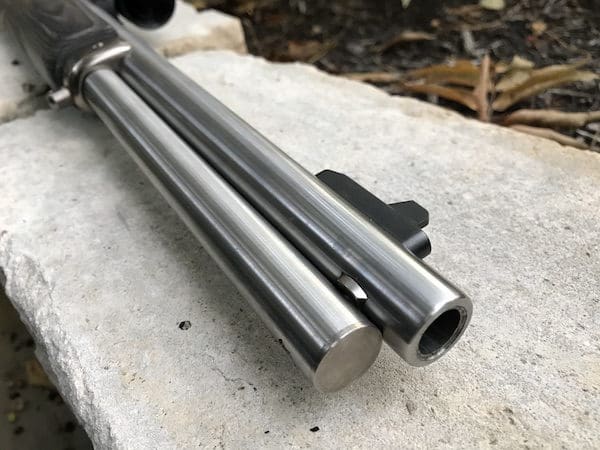
I’ve written about the potential of the modern .45-70, as realized by boutique ammo companies like Garret Cartridges. Shooting properly formulated ammunition, this 144-year-old caliber can take down any animal that walks the face of earth. But you don’t have to push supersonic 540 gr. Hog Stompers through the air. You can feed the Outback Guide a commercial 250gr Hornady Monoflex round for a comfortable shooter that will still fell whitetails out to 300 yards.
This version of the 1895 holds six rounds of heavy grain goodness, plus one in the pipe. So, with one fully loaded Outback Guide lever-action, a little luck or a lot of money, I can take the five whitetail and two mule deer my Texas hunting license allows. Or a metric ton of pigs. Or a Cape buffalo. Or maybe have four rounds to save my hide after I miss a charging grizzly with the first three.
The original 1895 attaches the receiver to the stock by squeezing the wooden stock between the receiver’s top tang and bottom metal with a bolt. If the metal-to-stock fit is good and the wood’s hard and remains well sealed, it’s not an issue. In the real world, on a hard-used rifle shooting heavy loads, it’s a potential problem.
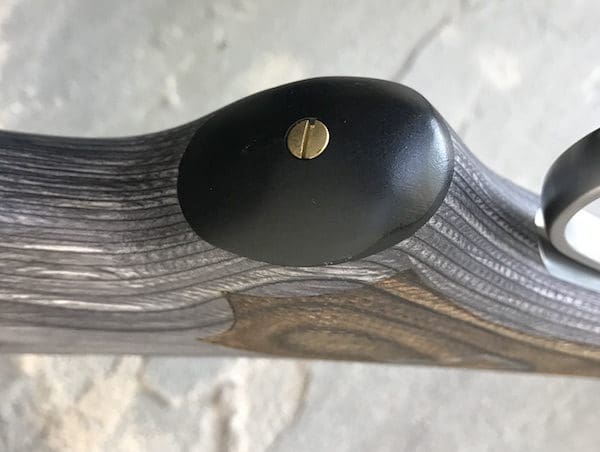
Grizzly nixes the problem by installing a bolt from the receiver through the stock. If you’ve taken apart a Remington 870 shotgun, this solution will look familiar. The “fix” certainly shores up any potential issues, and snugs the stock into the receiver. I’d definitely note the tension on the bolt when loosening it for disassembly; over tightening it could have disastrous results.
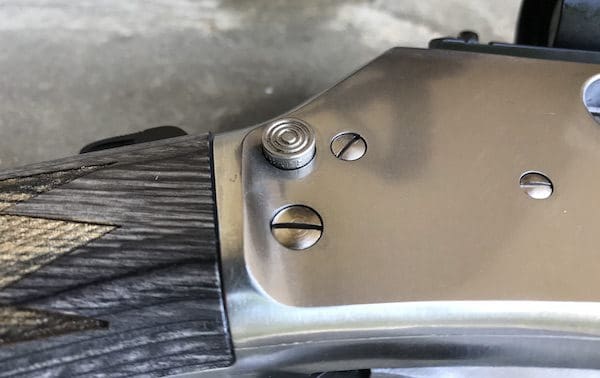
The Outback Guide’s cross bolt safety fell easily to my firing hand, snapping on and off with surety. It’s especially useful to be able to activate and deactivate the safety while holding the lever gun on target — something a squishy safety doesn’t allow.
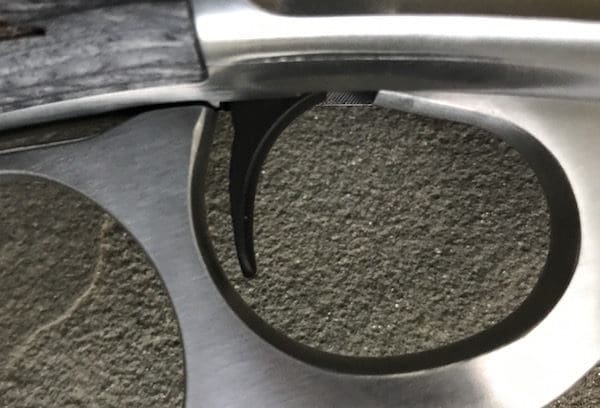
Grizzly breathes heavily on the 1895’s trigger, creating one of the best triggers I’ve ever felt on any rifle (save the under one-pound triggers fitted to some long-range precision rifles). It’s infinitely better than any factory rifle trigger I’ve shot — just as good as the Jewell triggers on my Remington 700s.
For an additional fee, Grizzly will straighten, dehorn and round the end of the Marlin’s trigger, and then refinish it in black Cerakote (as above). I reckon it’s well worth the $60 upcharge.
The Outback Guide’s trigger breaks at 2.5 lbs, but you’d swear it was less. There’s zero creep, no fuzziness and not a hint of sloppiness. It just barely surprised me every time. The wall of tension is there . . . and then it’s gone. It’s just perfect. After shooting the Outback Guide, I went and shot my 70-year-old Winchester 1894. And hung my head low in sorry disappointment.
The Marlin 1895 is an extremely robust platform. That said, I’ve had issues with the magazine hanging up, and rounds getting out of position during a slow or fumbled cycling. If the Marlin 1895 is built like a tank, the Grizzly Custom Guns’ Marlin 1895 is built like a Swiss tank. I slowly cycled the action, I quickly cycled the action and I stutter-cycled the action without a single feed or extraction hiccup.
The Outback Guide was lubed when it arrived. I didn’t clean or lubricate it until I was done with the review. I put a total of 300 rounds through the gun, including rounds from Federal, Hornady, Garrett, Winchester and my own reloads from cast boolits. I shot multiple types of rounds, from flat-tipped lead round-nosed, to hollow points, to hard cast solids, to the Hornady FTX projectiles, in bullet weights from 250 to 420 grains. Zero issues.
I’d trust this gun with my hunt or my life any day.
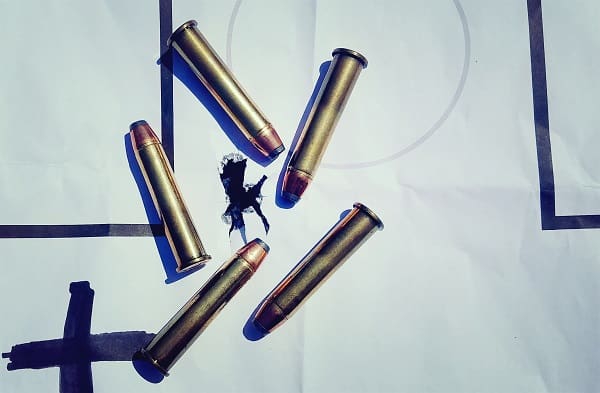
I had the Outback Guide gun for a little longer than I was supposed to. There was a two-week gap between accuracy tests. When I looked back at my notes, I thought I’d measured the group size at the wrong distance. My next eight groups of five rounds proved I was not in error.
The worst shooting round out of this gun scored 1.2″ five round groups at 100 yards. That’s good shooting from a lever gun. But wait, there’s more! That wasn’t a commercial round. It was my own reloaded starting load that I use for deer hunting.
The worst commercial round — the Hornady 325gr FTX LeveRevolution cartridge — shot 1.1″ groups, on average. The Winchester Super X 300gr JHP shot .8″, and the Hornady LeveRevolution 250gr Monoflex shot right there with it. I only had five rounds of Garrett 420gr Hammerheads; they printed right at the 1 MOA mark.
Those are average five-round groups shot at 100 yards off bags, untimed, using the Leupold VXR 1.5 – 5X scope provided by Grizzly Custom Guns. If you can account for the windage and drop, the Outback Guide is easily a 300 yard deer rifle. Choose your round carefully and your bullet will arrive at that distance with authority.
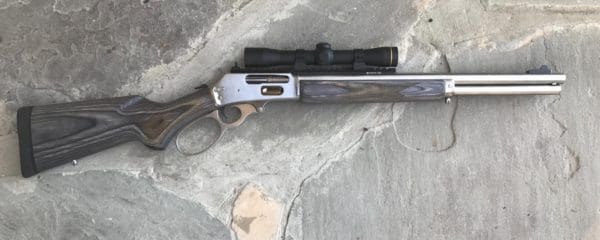
The Grizzly Custom Guns Outback Guide lever gun costs $800 more than a new Marlin 1895’s MSRP (and doesn’t include the gun). It’s a full grand more than a new Marlin 1895SBL. I wouldn’t own a new Marlin 1895SBL. Not when I can have Lew Bonitz take a good design and turn it into a great one. Creating a gun that offers truly exceptional accuracy and reliably for generations. If you want uncompromising attention to detail provided by a gunsmith who has a complete understanding of the platform, the Outback Guide Gun is the one.
Grizzly Customs 1895 Outback Guide Gun in .45-70 Government
SPECIFICATIONS:
Base Rifle: Marlin 1895SBL Barrel length 18.5 inches
– Barrel recrowned w/11° target crown
– 6-round, full-length magazine tube
– Laminated stock, grey & black
– Pachmayr Decelerator recoil pad, contoured for easier mounting & dismounting
– Extensive action tuning to feed everything up to & including Garrett 540 grain Super Hard Cast loads
– Trigger job on factory components
– Dehorned factory large lever loop
– Complete action dehorning
– XS Sights ghost-ring rear sight
– XS Sights ramped front sight with high visibility insert
– XS Sights Scout scope rail
– Stainless steel, finished in matte or factory style
– Modified loading gate for easier loading
– Extensive action smoothing
– Bed stocks
– Through-bolt stock retention system
– Test fired & sighted-in
MSRP $1,995 ($800 less if you supply your own rifle.)
RATINGS
Fit and finish * * * *
I can’t give the Outback Guide five stars; it’s just a laminated stock. But the finished gun’s wood-to-metal fit is excellent, and the stock itself is well checkered and attractive. The satin polish across all of the metal parts is even throughout, and the melting and blending of the sharp edges is ideal.
Reliability * * * * *
No issues over the entire process with any round of any type.
Accuracy * * * * *
Ridiculous. The worst round printed at 1.2″ on average — and those were my handloads. Every commercial round shot 1.1″, or better.
Overall * * * * *
I always look for something to disqualify a gun from a five-star rating. I couldn’t find a single thing to ding. Lew Bonitz at Grizzly Custom Guns has built an absolutely exceptional rifle. My next three generations could spend their lifetimes hunting with the Outback Guide and it would remain as it is now: a beautiful, robust, supremely capable firearm capable of taking any game, anywhere.

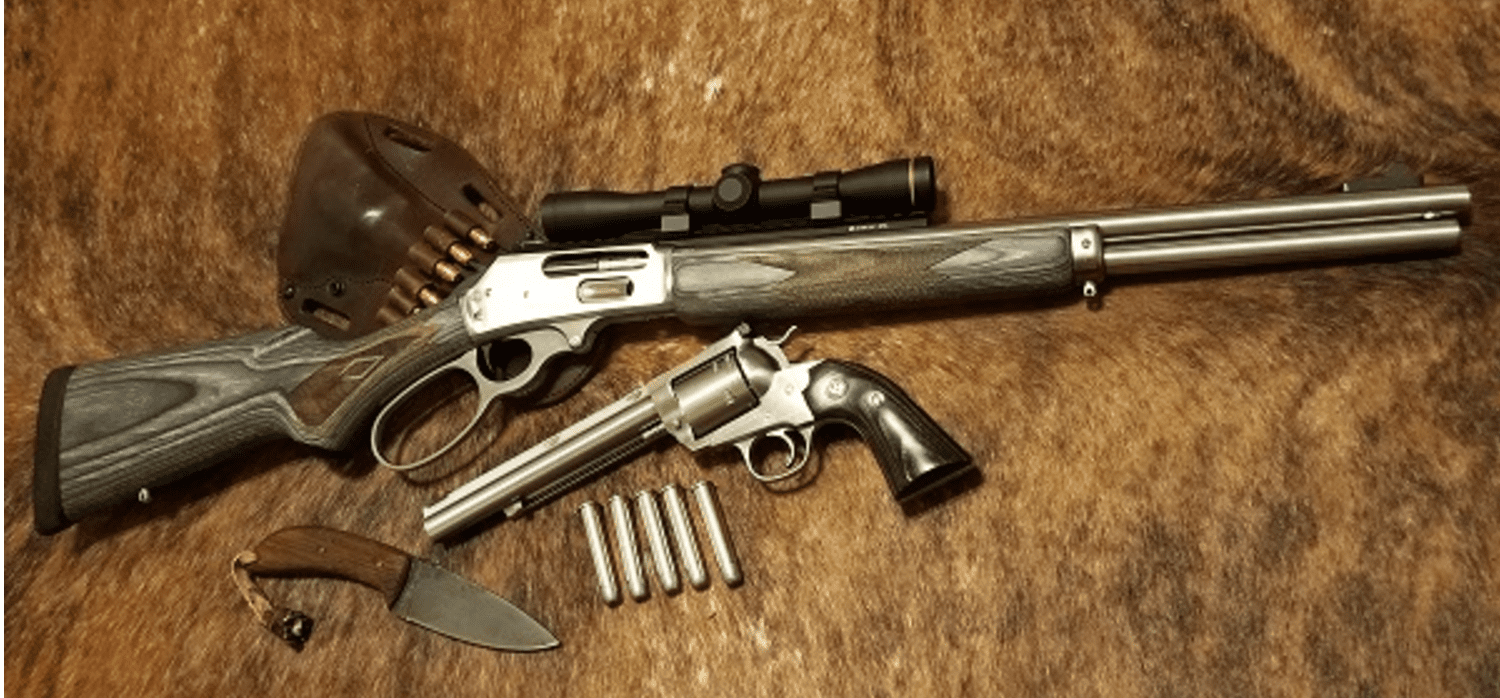



For $2k, it ought to be good.
OK I have been thinking about this question and figure that there is enough of a wealth of knowledge amongst the users here to post it:
What explains the continued popularity of the 45-70 Government cartridge in new guns? Is there not a modern replacement? Wouldn’t a modern cartridge NOT developed in the black powder era have appreciable advantages over the 45-70? For example, smaller case volume means less of the same powder to achieve the same velocity, meaning less recoil? Smaller case length meaning more rounds can fit it in the tube magazine? Ammos weighs less, takes up less space…
For example, would 460 or 500 S&W magnum not make for improved replacements over 45-70?
“What explains the continued popularity of the 45-70 Government cartridge in new guns? Is there not a modern replacement?”
I’ll offer a WAG.
The extreme length of the cartridge case offers a very wide range of powder loads possible.
And projectile lengths possible…
Nailed it. For the reloader, the 45-70 Government, like many of the old school straight walled black powder cartridges, can be extremely versatile. In this particular case, you don’t even have to hand load. Take a look at the range available just in my article. You can more than double the bullet weight with commercially available ammunition, and there is something commercially available throughout that range.
But isn’t there a lower limit to the volume of powder you can load? My understanding is that problems start to arise when trying to create soft loads using modern gunpowder in black powder cartridges. The primer might not ignite the powder, or when it does ignite the powder, it might not burn in the desired consistent fashion. At least this is a stated concern of competition shooters. Maybe if you intend to use it as a brush gun at short ranges it doesn’t really matter. Still seems like yet another advantage for a smaller casing: more consistent powder ignition across the entire spectrum of desired pressures.
But to your point, the wide availability of off-the-shelf cartridges is probably the biggest factor. Does anyone even make 460 or 500 S&W Magnum cartridges optimized for rifles? I haven’t seen it.
My pet load is a cast 405gr on top of 14.6gr of Unique powder. Pretty much duplicates the ballistics of the old 45/70 government BP load. I can’t remember my hunting load off the top of my head, but it’s like 50gr of 296 with a 350gr Hornady. Being able to do stuff like that is why I love it.
It’s a bit complicated:
The main weakness of black powder cartridges was the upper velocity limit due to the type of propellant. The bullet from a black powder rifle is only going to go so fast… so if we can’t make it go faster and want more power, the solution is to make the bullet bigger. Hence, the ,45-70 is huge by modern standards yet is still poking along at a relatively slow pace.
When we rephrase the question to “how effective is it on game compared to contemporary loads?” the answer gets trickier – do you subscribe to the Velocitas Eradico(speed destroys) theory of stopping power or are you in the Elmer Keith camp (big and slow FTW)? Both theories have valid points and loyal adherents. The best answer to “should I get a .45-70?” may be to decide based first on its limitations and ask yourself if it’s a deal-breaker:
Is it a fast load? No.
Does it have a flat trajectory? No, “like a football” applies here.
Does it have heavy recoil? In light loads it’s more of a shove than a kick, in heavy loads its still a shove but this time it came from a truck.
Can I take large game with It? Any animal it couldn’t take has been extinct since the last ice age.
So make up your own mind.
“For example, smaller case volume means less of the same powder to achieve the same velocity, meaning less recoil?”
Smaller case volume while pursuing similar velocity/energy equates to more pressure, which increases blast and maintains similar recoil. If you haven’t ever fired low-recoil or “Springfield” .45-70 loads, they are really a treat, and the downrange experience will still be very unpleasant for the catcher.
I know I’ve seen some lever actions chambered in .460/.500 Magnum, though I’m not sure who manufactures them, and that would make an awesome lever action/revolver combo when paired with an X-frame. Probably a bit overkill for anyone living outside of Alaska though.
There have been such cartridges that exist, I believe that was the initial goal of the 458 Socom. As said though, powder capacity lends versatility to reloaders.
Besides this, if you look back there are a few standard cartridges that people flock to and a myriad of “johnny come lately” cartridges that fell by the wayside at some point. It also goes to show the impact military adoption for a significant period of time has on the success of a round; Sure there are some that have failed to stick with us (6MM Lee Navy, 30-40 Krag) but most of the ones with any sort of longevity of adoption in the US have stuck around for a long time (5.56, 30-06, 308, 45-70, 45 ACP in handgun.)
I don’t think of the .45-70 as a stodgy old round, I think if it as a .450 / 400 Nitro Express that I can afford to shoot, or a lite .458 Win Mag. It’s a brush round that hits deer with authority. Sure, the 6.5 Creedmoor is way more sexy, but it won’t drop a deer as fast inside of 200 yards, nor will a .308. There’s just something cool about getting close to your quarry with a big, fat bore.
As to .460 and .500 Smith lever guns, I’d happily take one. They can be had, but for a hefty price. Marlins and Henry’s are available at an honest man’s wage, and the biggest they chamber is .45-70.
I think the appeal of a 45-70 lever gun is it’s handiness and value. At 7-8 lbs it is much lighter and typically shorter than other designs and it has the fastest manual action. And a basic one is relatively inexpensive. Most newer designs use cartridges that are excessively powerful (too much powder equalling too much pressure and recoil without better performance on game) With modern bullets (thick copper or brass jacket or solid copper or brass) there is nothing a lever gun in 45-70 can’t do. Why carry a 13-14 lb double rifle that sets you back ten grand or more when a lever gun will do?
This looks like an alternative to a 45-70. Check out the performance section vs 458 socom and 50 mag.
http://www.45raptor.com/45RAPTOR/
45/70 ended up being an excellent “modern” cartridge, even after black powder stopped being the propellant. To your case, the original government “buffalo” rounds in 45/70, 45/90, and 45/120 ended up favoring the smallest of the cartridges with smokeless powder. The reason for its continued use is multi-faceted. Strait-walled cartridges tend to last longer and be easier to customize, for the reloader. They also feed better in lever guns. Better bullets continue to be designed for it and thus better accuracy, penetration, etc. Smaller cases require faster propellants, which don’t lend well to accuracy and usually create “snappier” felt recoil. Some of this info may be subjective, but I hope it gives you a perspective of why some people continue to enjoy the round.
This is one excellent example of, “You get what you pay for!”
They definitely cleaned off the rough edges of the 1895. Marlin’s quality control is not what it used to be. With that said, my bone stock 1895 XLR 24″ Marlin can shoot 1.5″ 3 – shot groups at 100 yards (I usually shoot 5-10 round groups but with a .45-70 I figure 3 is decent) with Hornady 325 grain LeverEvolution. Mines reliable with Buffalo Bore 300-405 grain and the bone crushing Underwood .45-70 +P 305 grain Extreme Penetrators. My buddy bought a new 1895 Guide Gun and had it choke up on him. Not sure what work all needed to be done, but he got it sorted out with a good gunsmith.
I’ve got a Leupold 2-7 scope on mine. I think I could be right there with this gun with maybe just a trigger job, although my wood to metal fitment is not nearly as tight. Going down to an 18.5″ barrel would account for most of the barrel rigidity / accuracy increase. That target crown looks sweet.
I wish I could get Henry quality with Marlin features. I want a side loading gate, and the stainless / laminate look is beautiful.
I’m with you on the side loading gate, I simply do not like the idea of manipulating a tubular magazine where my body parts are near the muzzle, especially with a cannon like this one…
I hate being a nit-picker, I really do, but please everyone, stop using caliber and cartridge as though they were interchangeable.
Ok, now review a recent manufacture, fresh from the factory Remlin. And a pre-Freedom Group Marlin. Compare and contrast them all.
Ha.
I have a new 1895 and an old 336. The quality of the new ones are pretty good these days. Aside from a very heavy trigger pull and some edges that are not quite as smooth as the old one, I don’t notice any difference in overall quality. New one has more of a matte finish in the bluing and the wood, where the old one has a shine to both. Quality of wood and finish is equal, but definitely different.
Given a choice, I’d rather have one of the old ones, but I wouldn’t necessarily shy away from the new models either.
I’ve got a 2016 1895SBL and a 2013 336Y. Both are fine function wise, though the 336Y’s flat parkerized looking barrel finish is a little cheap looking. I’ve got no complaints, it was $300 after all. Even the laminated stock looks great. The 1895SBL is a beauty though, love cycling dummy rounds through it. Only gun I bought last year.
I have a guide gun in stainless. I took it to Fred at CAR firearms, and he went through the whole gun and polished the internals, and did a trigger job. Costs me $500 including the laser etched initials on the receiver. This is far less than the Grizzly, and it is as smooth as butter
Thanks for the reference. I have an 1895CB 26″ (pre freedom). Beautiful gun. Going to check into this. Those things are about all I would want done.
I’m usually not drawn to the expensive/custom end of things, but if I had the scratch I absolutely would buy one of these. It’s beautiful in every possible way. Been wanting a .45-70 for a long time, and I’ve been a sucker for leverguns ever since I first fired one.
this is 1200 dollars less than the previously reviewed brush hawg.
for whatever reason (mostly my affinity for .44mag) i went with .444. it doesn’t lag too far behind the older round.
i could see sending it off for some tuning. at least pull in one of those half hoop levers…
harmfist just had a savage99 in .308 surface for three hondo. it was gone before the owner got back to me. boo.
I like the 45-70, would love a lever gun in it, but only have a Ruger #1. As a hunting rifle its a nice setup, (much easier to unload at the end of the day with a single shot if it was uneventful). Those big rounds are also a lot easier to handle with frozen fingers than the smaller modern stuff…something many don’t think about. Not thats its all that important, but its a plus.
What I’d love to see are the other “sharps” rounds in new guns (single shot and lever) Keep in mind the 45-70 was on the small side. It was a combat round, for men and horses.
I think the Sharps rifles went up to as large as 50-140 and possibly up to 50-170 (.50 cal. 170 gr. powder. 700 gr. bullet) The .50 cals were the real Buffalo guns its said.
Anyone know for sure how big they got?
The military .45-70s were not all carbines for mounted soldiers, but included converted Springfield rifles, and ultimately a dedicated full length rifle.
The story begins with the .50-70, adopted at the end of the Civil War, and built from resleeved .57 cal rifled muskets, but that was quickly superseded by the .45-70 for the 1873 rifle (not carbine) for reasons of which I am unaware, firing a .405 grain bullet. In 1879, there was a series of famous tests at the range in Sandy Hook, New Jersey test range, where the round was tested for volley fire out to 3350 yards. At that range, accuracy was minimal, but penetration was still substantial. As I recall, bullets were found buried 8 inches deep in the sand after penetrating a 4″ thick wood test target. The results can still be found on line. In any event, those tests resulted in the Army adopting a 500 grain bullet for the rifle, and it remained in use until smokeless powder and bolt fed rifles took the world by storm.
The buffalo hunters used both .45 and .50 caliber rifles, with ranges reported out to half a mile. Either they were very good shots with their scope sighted 36″ barreled rifles or accuracy wasn’t all that critical when shooting at a vast herd. There are competitions to this day using black powder .45-70s at ranges up to 1000 yards.
p.s.: According to Chuck Hawks, your Ruger No.1 has been handloaded to 50,000 cup, almost double the standard pressure. http://chuckhawks.com/45-70Govt.htm
Ah yes, the rifle used in Wind River, cool review, awesome gun!
Beautiful.
Gentlemen,
Here is my personal experience. I have copied the following two updates from my web page, GrizzlyCustom.com.
“Update June 25, 2017 – I just purchased my first new Marlin since before the Remington takeover. I was extremely hesitant to say the least. As it turns out, it was a pretty nice rifle, not perfect, but nice. I have just ordered two more 1895’s, a 336, and an 1894 to see if they are similar in form & function. I hope so. If I supply the rifle for your project and there are issues, I will fix them. If you supply the rifle, I may charge you (or not), depending on the severity of the problem, especially if the rifle was early in the Remington days of production. I will update this after I see the next few rifles.”
“Update July 26, 2017 – I have had a chance to build the 336BL, the 1894, and the 1895GBL, as well as another 1895SBL that I purchased recently. While not perfect, they were very nice rifles. The machining quality was better than I am used to seeing on the older rifles. Just a few tweaks here and there were all that was needed. I will continue to buy new rifles for the Outback series of rifles I am building, they work very well.”
The reason I originally pursued the new Marlin rifles was to have something to compete directly with a similar “Brand X” offering. It had to be of good quality, and readily available, or it wouldn’t work. I don’t have time to search out a nice used gun for every customer that wants one. I figured that if Marlin could get me a rifle that was 90-95%, I could iron out any issues I found. It seems that Remington has finally figured things out, they are at least 95%. The machining quality is better that I have seen, even on the older rifles. The fit & finish is pretty nice, although their checkering still leaves something to be desired. I do not see the myriad issues that were present on the new rifles of even a few years ago.
I like to think that I have succeeded in providing more “Bang for the Buck” than your other options if you are looking for a custom Marlin lever action rifle; that you can have shipped within 30 days or so, sometimes immediately. As mentioned in the second update above, they are also available in blued versions of the 336, 1894, and 1895 if you like those flavors.
I hope the information helps.
Sincerely,
Lew Bonitz
Grizzly Custom Guns, LLC
Looks like a good firearm, but why in the world anyone would want to start ruining the barrel by running their own “reloads from cast boolits” is just beyond comprehension.
Very good review and very nice gun!
how do you know when the marlin you are looking at is a newer model or one of the first RIMLINS they were building?
Gear up as your favorite Delsin Rowe Vest. Slim Fit Leather Jackets brings this iconic jacket from animation to reality, especially for all the fans of this video game. Delsin Rowe is the main protagonist and playable character, a young Native-American man who later realizes he’s a Conduit with special powers.
Comments are closed.